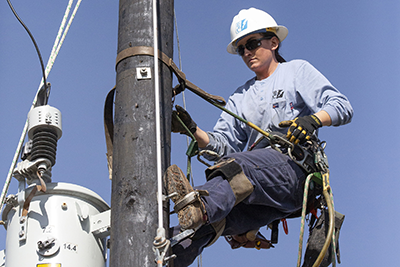
The only woman among the 210 lineworkers at Pedernales Electric Cooperative (PEC) in Johnson City, Texas, 21-year-old Vaillancourt is a little less than halfway through the four-year process of becoming a journeyman.
Her progress has impressed her teammates.
“This is my 22nd year in the business, and I’ve come across every type of personality, style, and background,” says Jason Foster, Vaillancourt’s supervisor. “Kaitlyn has a passion for this industry. … The main thing at this level is attitude, and hers is very good.”
It’s a foggy, unseasonably warm January morning in the supply yard of Pedernales’s district office in Kyle, and Vaillancourt is starting a new rotation on Foster’s crew. She’s helping another apprentice load 40-foot poles onto a trailer and chatting with other crewmembers about the plan for the day.
In April, she’s due for a big change: promotion to third-year apprentice. That’s the year Foster says most apprentices drop out, daunted by the pressure of retaining what they’ve learned and mastering new, more technical skills. It’s also the first time apprentices work on energized lines.
But Vaillancourt thrives on variety and says the combination of critical thinking and outdoor work is what drew her to the lineworker trade.
“I like to use my body and put things together,” she says. “I was never satisfied in those other jobs. I was working at a pizza place, and I was like, ‘I want to use my brain and not just do mindless work.’”
A ‘man’s job’
PEC hired Vaillancourt in 2017 as part of a multi-year recruitment campaign to stay ahead of a trend of retiring lineworkers, an industrywide problem. It takes at least four years to fully train a lineworker, and candidates who are mature, responsible, driven, and unfazed by heights and high voltages are becoming increasingly elusive. Compounding the problem is a talent pool that is effectively cut in half because line work is an overwhelmingly male-dominated field.
“Because the decreasing pool of lineworkers is recognized nationally, PEC had to develop and maintain a more consistent presence at [line work] schools in order to observe students that appeared to have the most promise and potential for longevity in their career,” says James Vasquez, PEC’s interim director of safety and technical training. Vasquez’s mother, Rosa Maria, was a career lineworker at Central Power & Light in Texas and is the only woman inducted into the International Lineman’s Hall of Fame.
Line work as a “man’s job” is a bias with deep roots.
“Most students in our line work programs are there because their father, uncle, or father’s best friends were linemen, and they recommended it to them,” says Leilani Todd, vice president of human resources at Mecklenburg Electric Cooperative in Chase City, Virginia. Todd also serves as an executive council member at the Center for Energy Workforce Development (CEWD), a nonprofit consortium of energy utilities formed in 2006 to address industry workforce issues and needs. “And the physically demanding job requirements and our cultural norms have really self-selected men into these positions since the beginning.”
The numbers are unequivocal. At the end of 2018, there were 14,560 co-op line technicians, apprentice line technicians, and groundworkers. Only about 1 percent of those employees were female, according to NRECA employee data.
But there are signs this order may be changing.
At the Northwest Lineman College (NLC), Vaillancourt’s alma mater, of the roughly 9,000 students who graduated between 2008 and 2018, 22 were women. Melissa Yarno, the registrar at the school’s Meridian, Idaho, campus, says it seems a small number, but it’s part of a slow increase in women’s interest in the profession.
“The percentage of enrolled and graduated females has ebbed and flowed over the past 10 years, but there’s an overall upward trend,” Yarno says.
A perfect fit
Growing up in Chesterfield, Michigan, Vaillancourt never considered line work as a career.
“I’d never even heard of it,” she says. “I never saw, in Michigan, anyone working out on the poles, so it was really a random thing for me.”
She graduated high school in 2015 and bounced around local retail and food service jobs. By late 2016, she was looking for another challenge, eager to get her life started.
That’s when her brother showed her the NLC website.
“My first impression was that I’d have to work very hard to graduate because it seemed very physically demanding,” she recalls.
The college’s four-month pre-apprenticeship program was a perfect fit for Vaillancourt. Nearly all graduates get placed at jobs, and without shelling out tens of thousands of dollars for a four-year degree. Tuition at NLC is about $18,000.
“I had all these friends that were getting degrees and not ending up with a job,” Vaillancourt says. “I was like, ‘If I can do a program for four months and end up with a really good job with benefits, why wouldn’t I do that instead?’ Especially if it’s going to be what I like. I decided to give it a shot.”
Vaillancourt packed up her car in January 2017 and drove two days to the NLC campus in Denton, Texas, which had the first available openings. She’d found out a week before classes began that she would be the only female among 80 students.
“I was a little intimidated, but it is what it is,” she says. “If I gotta do it, I gotta do it.’”
Vaillancourt says adjusting to the grueling schedule of classwork, training, and testing was a challenge.
“It was competency-based, and you had to complete one each week in order to progress and get your certificate,” she says. “There was classroom instruction, and you’d have to take a test. Then you’d have to perform something in the field and do it in a certain amount of time.”
To keep up with the physical demands, Vaillancourt started hitting the gym, even though the curriculum was itself a workout.
“I would come home after school and I’d do upper body, lift some weights here and there, do some runs and make sure I was in tip-top shape so I could compete with the men.”
Even now, Vaillancourt continues her strength-training regimen at a gym near her home in San Marcos.
“A couple of months back, when I was trying to lift some wire out of a dolly and up into neutral, I wasn’t able to do it because the wire was pretty big. So that day I got a gym membership and decided to work more on my upper body.”
PEC made some tweaks before Vaillancourt started work, like ordering smaller gloves and work boots.
Beyond increasing her strength training, the only thing she’s felt the need to change was her quiet voice.
“I had to stop being soft spoken,” she says. “Communication is imperative in this field, and the lack of communication can get someone hurt.”
Foster says some crews worried whether a female lineworker could fit in, but says Vaillancourt has had no trouble developing a rapport with her co-workers.
‘Fire in the eyes’
A few hundred miles north of Austin, at Cotton Electric Cooperative in Walters, Oklahoma, Michelle Taylor recalls that her interest in becoming a lineworker was piqued in the early 1990s, when she worked as a meter reader at the co-op.
“When I was out reading meters, I would see the guys out building jobs and running outages,” she says. “I thought to myself, ‘That’s something I want to do.’ So when an opening in line operations came up, I applied for it. I did the physical test that we had at the time and passed with flying colors.”
Taylor learned on the job from co-workers and supervisors. She became an apprentice in 1995 and a journeyman three years later.
Her childhood spent on a ranch near Ringling, Oklahoma, building fences, breaking horses, and hauling hay, was good training for the rigors of line work, she says.
“I always worked a little harder. I know I have to show I’m right for the job.”
Taylor, 51, eventually became head lineworker in the co-op’s Walters district. A few months ago, she was promoted to a position supervising contractors.
Though Taylor and Vaillancourt are 30 years apart in age, and entered line work through different paths, they share a common outlook: Neither wants special allowances or watered-down expectations.
“They might have gone a little easy on me to begin with until they realized how I was and that I don’t back down for nothing,” Taylor says. “I pull my own weight.”
It’s the same with Vaillancourt: “I feel very equal. They make me feel equal. They don’t give me any special treatment, which is what I want.”
That drive is common in female line work students, says NLC President Aaron Howell.
“There’s a fire in the eyes,” he says. “They’re so inspired, and they’re so hard-working. They do their homework typically more than anybody else, and they come in well-prepared.”
He notes that modern advancements in line work tools and equipment have diminished the impact of any strength disparities between men and women.
“If you look at the typical job description for a lineworker, the lifting requirements use to be 65 to 75 pounds,” Howell says. “When hydraulic technology became more common, tools, equipment, and materials were available for anyone to lift anything. Line work is a more inclusive path, when before it didn’t always used to be.”


